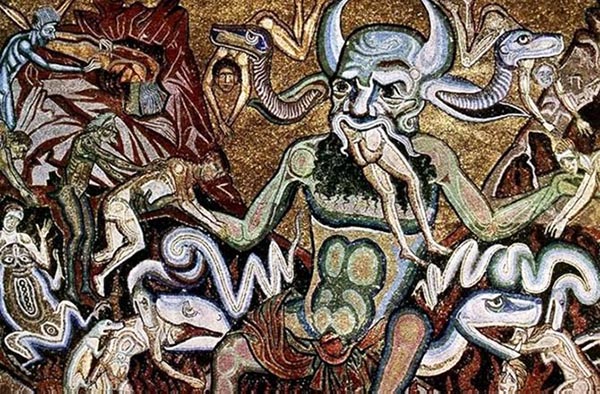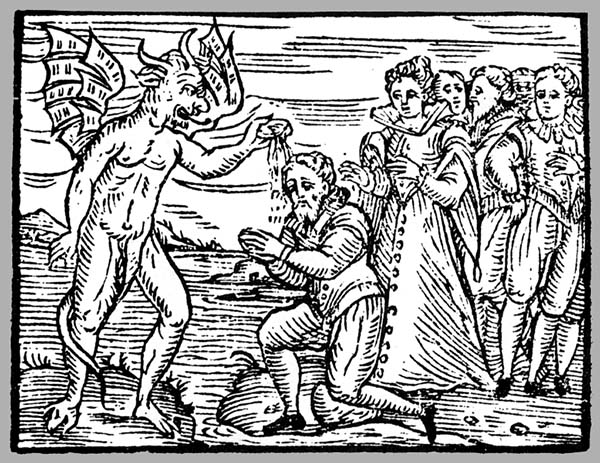NOTHING TO BE AFRAID OF
part II


Much of the shift from normal to paranormal happened during the Dark Ages. Famine, pestilence, plague, slaughter, pillage, barbarian invasion, social decline, cultural collapse — there are good reasons why this era is so aptly named. These were times when humanity seriously lost the plot. And stirring this concoction of doom was the new kid on the block, the Roman Catholic Church, whose intolerant attitude to anything outside the confines of its orthodox view was in full zeal by the 7th century.
Following the first ecumenical council in Nicea in 325 CE, it was agreed by the bishops in attendance that only a select number of Christian gospels should be included in the official church cannon. What was removed (or covered up) were such esoteric writings as the gospels of Thomas and of Mary Magdalene. In so doing the Church began its systematic dismantling of feminine power throughout the known world. The low point culminated with the burning of millions of women falsely accused of witchcraft. But we are getting ahead of our selves.
Of importance to our discussion is the preoccupation by the Church fathers of all things evil. With the fall of the Roman Empire and the rise of conflicting ‘barbarian’ hordes, all of Europe was awash in blood— literally. The emerging Church saw this time as an opportunity to flex its muscle upon a largely illiterate society, and fear would become its most useful tool. And what better way to bring people to the protective bosom of the Church by making evil the culprit in every situation. Evil brought the plague to your town, evil took your wife to hell; evil, not malaria, consumed your children, evil was the vermin behind your failed harvest.
By the 11th century evil was the stranger skulking on every corner. And who better to personify this unseen danger than some misshapen character called the devil. With the Church pushing God as the supreme light, a mirror-character was required to personify everything that was outside orthodox scripture, or ‘good’. Let us remember that the success of any conflict has always been defined by who we chose to accept as the scapegoat, and in this grab for the control of human souls, Lucifer became it.
‘Devil’ stems from the Greek diavolos, meaning ‘one who throws across’. So far, nothing too malicious or paranormal about that. But given the Church’s disposition towards pagans (whom the church also considered evil, even if pagan simply means ‘one who lives in the country’) it was not long before Pan, the pagan god of fecundity and nature, was retrofitted to become the horned, half-man half-fawn creature and the Church’s best recruitment officer. Thus, our irrational fear of the devil, the central protagonist in the land of the paranormal, is nothing more than a misplaced belief: fear of the very force that gives birth to everything in life, including ourselves: nature.
Strictly speaking, to fear the paranormal is to fear the unknown, and in today’s societies that means the fear of evil. But what is evil? There are several schools of thought on this. The origin of the word comes from the old English yfel, whose roots are linked to eve, the primordial woman. Given the Church’s position on the divine feminine, the connection seems very plausible. After all, we have been brainwashed to believe that it was this luckless woman (whose Hebrew origin havva and hayya means ‘living’) took a bite of the apple of knowledge which led to her expulsion from Paradise, along with that of her husband Adam. Since then, all patriarchal societies have had a green light to blame, nay, persecute women for any ill that befalls them. So far this is in complete concordance with the patriarchal position of the Church.
But wait. That apple: wasn’t it a serpent who whispered bons mots into Eve’s ear and made her partake of the forbidden fruit? And isn’t the serpent one of the many disguises worn by the devil?
So we are made to believe. The devil, of course, also went on to inherit other roles such as the vampire bat, the goat, the rooster, flies, even the black pussycat. Yet despite the obvious brainwashing, our heart rate revs closer to red whenever we see the image of the goat superimposed on an inverted pentagram. This was yet another concoction by the Church. People have an equally irrational fear of snakes, quite possibly for the same reason (myself included, and yes, I was raised as a Catholic). If you doubt any of this, watch people on the street give a very, very wide berth to any passing black cat.

Such associations, once ingrained in the subconscious, particularly by seemingly trustworthy political and religious offices, can take generations to overcome. Take for example the paranormal connotations surrounding the number 13. To this day many prominent buildings in the western world have no 13th floor— a supernatural feat in itself, when you think about it, because the 14th floor IS the 13th, the upper part of a building doesn’t float in mid-air!
Collective fear of the number 13 is such that it even has its own adjective: paraskevidekatriaphobia. In America up to 21 million people are negatively affected by this number whenever it occurs on a Friday, costing the economy an estimated $800 million in lost revenue. It can be argued that such a mass belief inevitably becomes self-fulfilling, and yet in Holland accidents, fires and thefts occur at a lower rate on this day because people are generally more vigilant of the forces of evil.
Thirteen’s drawing of the short straw can be traced back to two pivotal events in history. The first occurred on Friday the 13th October, 1307. On this most infamous of days, orders from the Vatican enforced to exterminate the entire order of the Knights Templars. The original Templars— along with related Orders such as Cathars, Albigensians and Bogomils— pledged allegiance to the divine feminine, not to Rome. They served Isis, Mary Magdalene, and honoured the rising of Sirius, whom ancient societies equated with universal wisdom and truth.
The second event goes back to the negation of the divine feminine in everyday life by an encroaching patriarchal society through such things as the superseding of the 13-month lunar calendar by the 12-month solar cycle. In ancient traditions, lunar is equated with feminine, due to the Moon’s influence on water and fertility cycles; and solar with masculine, due to its explosive ferocity. This change started as far back as 1300 BC.; it was further implemented by the Romans and later enforced by its secular arm at the Vatican.
It only takes a small effort to understand how such concepts can alter our perception of reality, and yet to this day the association between things evil or paranormal and the 13th and/or Friday continue to be reaffirmed, albeit for commercial exploitation: films such as Resident Evil 5 and Friday the 13th were released on… you guessed it; not to mention one of my favourite albums, Black Sabbath’s eponymous debut LP. Even the opening of 2012 is set for release on Friday November 13th, 2009. While marketers see such associations as harmless fun, all it does is help reinforce and prolong an institutional belief system.
Our relationship with the paranormal is to a large degree shaped by lingering superstition. Superstition is what remains after the underlying understanding behind a fact has been distorted or lost. Take the devil-serpent association: the serpent or dragon has forever been a symbolic representation of one of nature’s fundamental motions of energy, the meandering pathways of magnetism that slide along the Earth. These are the same energy pathways upon which sit countless sacred sites— the temples once designed to help you reconnect with the invisible world. In the old days you did not need a bishop to act as intermediary (and an unreliable one at that) to help you speak to God. You could do it all by yourself by visiting a pyramid or a stone circle. Back then it was perfectly acceptable to eat the apple of knowledge, because with total knowledge comes total understanding, and with understanding comes a lack of fear. And without fear all that you don’t see suddenly becomes your friend. As Jesus once taught, “Know Thyself”. But such self-awareness did not allow room for the rising class of religious middle men aiming to keep a safe distance between you and God. There’s a strange irony here, for in Latin, the origin of the word ‘religion’ is religio, which means ‘reconnecting’. Yet by painting a supreme creative force as external rather than internal, religion is designed to do the very opposite. And what lies beyond the physical and the rational belongs to God; and the rest, to some seemingly very unpleasant and ugly entities.
Our symbiotic relationship with the paranormal has shifted over the course of time, and demonstrates how far, as a global society, we have shifted from total understanding to ignorance.
It also makes for a gripping script. Mass consciousness evolves in periods of roughly 4320 years. During each period humanity strives to have a collective experience. Between 6628-2308 BCE cultures such as those in Europe worked with the feminine principles of nature: cooperation, nurturing, the greater good of the tribe, and the implementation of a lunar-based culture.
By working with the life-affirming laws of nature, people were more sensitive to the forces that surround and permeate the tangible world, and were thus far better attuned to its subtleties. They sourced locations rich in magnetism, where even the force of gravity is lessened. In harnessing these basic principles they forged a closer bond with the unseen universe. The payback for such a relationship was the maintaining for thousands of years of a society that flowed in perpetual rhythm with all life. Some native cultures, such as the Aborigines, to some extent, still maintain such abilities of psychic perception.
Many of our ancestors’ shamanic experiences of the otherworld were carved in stone— from Egyptian hieroglyphs to Asian temple reliefs. Myths were constructed in which the acts of the gods would be memorialized for times to come, and many of their stories describe the physics of the universe. In the Rig Vedas there exist descriptions of nuclear processes now familiar to particle physicists.
Several of the parables in the New Testament of the life of Jesus are paranormal events in themselves, and they are brimming with esoteric wisdom and hidden information. The story of the miraculous catch of precisely 153 fish which occurs in the last chapter of St. John can be deconstructed to reveal a geometric framework revealing the cabbalistic Tree of Life as well as numeric values of great cosmological significance.
Continue to part III
Return to Articles